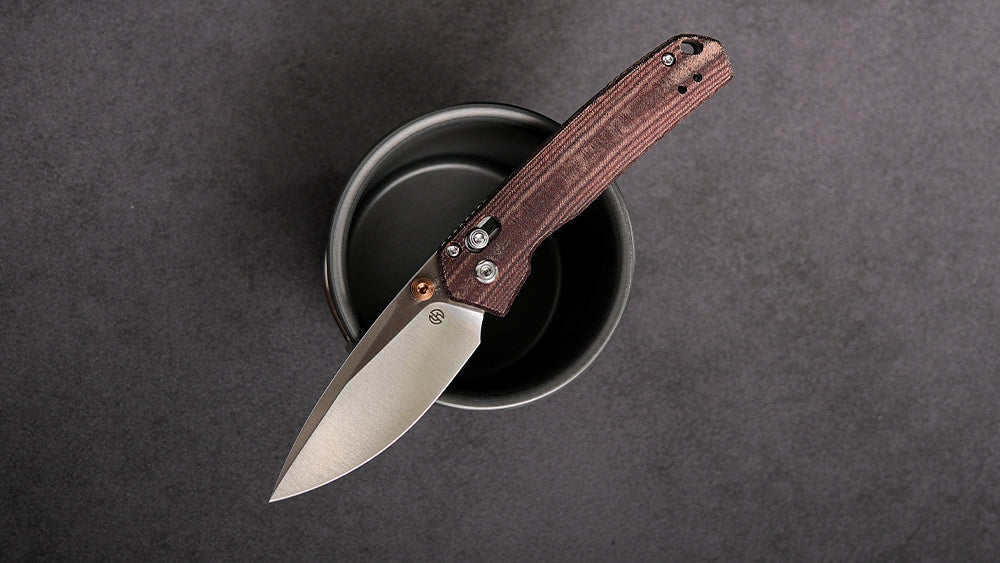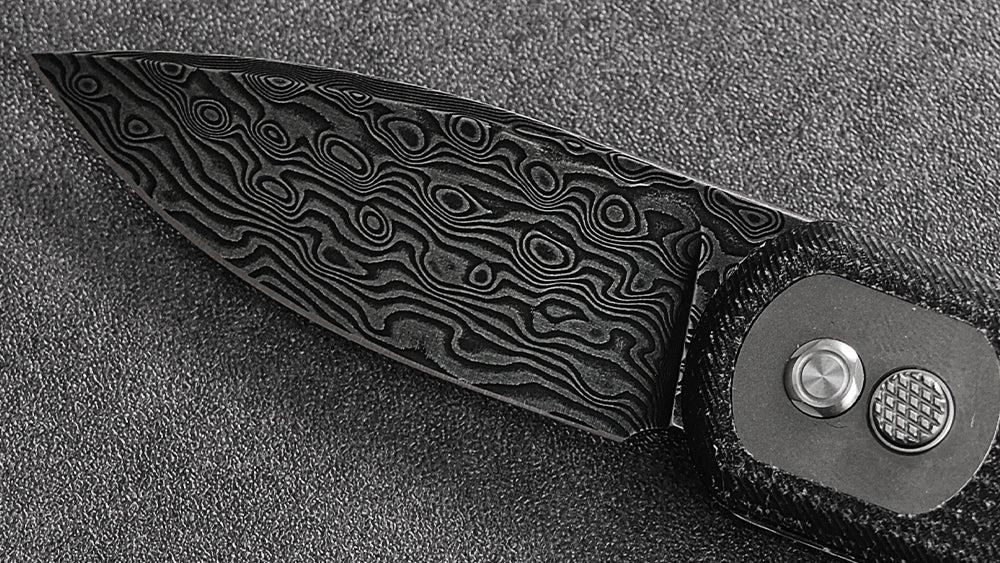Everyday Carry, or EDC, is a collection of useful items you carry on a consistent basis. These EDC tools are typically compact, durable, and functional. Among these items, a folding knife is one of the most versatile tools. Its history goes back thousands of years, a testament to its lasting utility. A good pocket knife handles countless daily chores. You can use it to open packages, cut cord, or prepare food. The right knife is a reliable companion for whatever the day holds.

Anatomy of a Modern Folding Knife
A folding knife has several key parts that work together. Understanding these components helps you select a better tool for your needs.
- The Blade: This is the cutting part of the knife. Blades come in different shapes and are made from various types of steel. Each combination offers different performance.
- The Handle: You hold the handle for control. Handles are made from materials like G10, titanium, or wood. The material affects grip, weight, and durability.
- The Locking Mechanism: A lock is a safety feature. It holds the blade open during use, so it does not close on your fingers. There are many types of locks, each with its own advantages.
- The Pivot: The pivot is the joint where the blade connects to the handle. A smooth pivot allows the knife to open and close easily.
- The Pocket Clip: A pocket clip attaches the knife to your pocket. It keeps the tool secure and accessible. Some clips let the knife sit low in the pocket for concealment, while others allow for faster access.
Choosing a Blade Shape for Your Package Opener Knife
The shape of the blade determines how well it performs specific tasks. For opening boxes and other daily utility, some shapes are better than others.
A Sheepsfoot or Wharncliffe blade is an excellent choice for a package opener knife. Both shapes feature a long, straight cutting edge. This straight edge functions like a utility razor, allowing for clean, controlled slices through cardboard and packing tape. The spine of these blades curves down to meet the tip. This design greatly reduces the chance of accidentally piercing the contents of a package. The focus is on slicing, which is perfect for work and general tasks.

A Drop Point blade is another popular option for EDC tools. It has a curved spine that drops down to the tip. This creates a strong point and a large cutting belly. A drop point is a great all-around shape, effective for a wide range of tasks, including slicing. It is a very versatile and reliable choice for general use.
A Tanto blade has a very strong, angular tip. Its primary strength is piercing tough materials. While it excels at piercing, it is less suited for general slicing tasks compared to a Sheepsfoot or Drop Point. The angular shape can also be more challenging for a beginner to sharpen correctly.
A Clip Point blade has a fine, sharp tip that looks like a section was "clipped" off the spine. This shape is excellent for detailed work and piercing. The tip, however, is thinner and can be more fragile than the tip on a drop point blade.
A Guide to Blade Steels for EDC Tools
The type of steel used for the blade is critical. It determines the knife's performance, durability, and maintenance needs. Four key properties define a blade steel.
- Edge Retention: This is the steel's ability to stay sharp through use. Steels with high hardness and wear resistance typically hold an edge for a long time.
- Toughness: This is the steel's ability to resist chipping or breaking under impact. Toughness is the opposite of brittleness. A very hard steel can sometimes be less tough.
- Corrosion Resistance: This is the steel's ability to resist rust and stains. Stainless steels are designed for high corrosion resistance, a vital feature for use in humid or wet environments.
- Ease of Sharpening: Some steels are easier to sharpen than others. For a beginner, a steel that is easy to maintain can provide a better experience than a super steel that requires special equipment to re-sharpen.
Comparing Common Blade Steels
Steels for EDC tools can be grouped into different tiers based on performance and cost.
Budget-Friendly Steels: These offer solid performance at a lower price point.
- D2 Steel: This is a tough tool steel with excellent edge retention. It is considered "semi-stainless," so it has decent corrosion resistance but will rust if not kept clean and dry. It is a great value for its performance.
- Mid-Range Steels: These provide a fantastic balance of all key properties.
- 14C28N Steel: This stainless steel is often recommended as a top choice for EDC tools. It has good edge retention, great corrosion resistance, and is very easy to sharpen. It delivers excellent all-around performance without a high price.
Premium Steels: These steels offer top-tier performance at a higher cost.
- CPM S35VN Steel: This is a popular premium stainless steel. It offers a great combination of toughness, edge retention, and corrosion resistance. It is also easier to sharpen than many other premium steels.
- Bohler M390 Steel: This is a high-end stainless steel known for exceptional edge retention and corrosion resistance. It will stay sharp for a very long time. The trade-off is that it is less tough and can be difficult to sharpen once it finally dulls.
For many users, a mid-range steel like 14C28N offers the most practical combination of performance and easy maintenance.
Looking for a practical EDC knife that uses 14C28N steel?
The Vosteed Corgi® V is a compact and well-balanced option that checks all the boxes. It features a 2.36" drop-point blade made from 14C28N steel—offering excellent edge retention, corrosion resistance, and easy sharpening. With its unique Vanchor Lock® for added safety and its fun-to-use wheeler opening system, it’s both reliable and enjoyable for daily tasks like opening packages. Weighing just 2.66 oz, it's discreet in your pocket and perfect for first-time EDC buyers.

Selecting a Handle Material for Your EDC Knife
The handle material affects the knife's grip, weight, durability, and appearance.
- G10: This is a high-pressure fiberglass laminate. It is extremely durable, lightweight, and provides excellent grip, even in wet conditions. G10 is a superb all-around material for any EDC knife.
- Micarta: This material is made from layers of linen, canvas, or paper soaked in resin. It offers a classic look and a warm, comfortable feel. Micarta's grip actually improves when it gets wet.
- Titanium: This is a premium metal with a fantastic strength-to-weight ratio. It is very strong, lightweight, and almost completely immune to corrosion. Titanium is often used for high-end knives that have frame locks.
- Aluminum: This metal is lightweight and durable. It is less expensive than titanium but can be more slippery if it lacks texture. Anodization can give aluminum handles a variety of colors.
How Your EDC Knife Lock Works for Safety
A reliable lock is a critical safety feature. It keeps the blade securely open. Some lock designs also offer greater safety during the closing action.
Liner Locks and Frame Locks are very common. A liner lock uses a metal liner inside the handle that springs behind the blade. A frame lock is similar, but a piece of the handle's frame serves as the lock. Both are strong and allow for one-handed operation. To close them, you must push the lock out of the way with your thumb. This action places your thumb in the path of the closing blade, so caution is required.
Back Locks and Crossbar Locks offer an additional layer of safety. A back lock has a rocker arm on the spine of the handle. You press the rocker to release the blade. A crossbar lock uses a movable bar that slides across the knife. To close either type, your fingers stay completely clear of the blade's path. These designs are very strong, ambidextrous, and exceptionally safe to operate, a great feature for new users.
Finding the Right Size EDC Knife
An EDC knife should be comfortable to carry and use. Blade length for an EDC knife typically ranges from 2.5 to 4 inches. A blade around 3 inches long is often a sweet spot. It is large enough for most tasks yet compact enough for easy carry. The weight is also important. A knife between 2 and 5 ounces usually feels solid without being a burden in your pocket.
A Beginner's Guide to EDC Knife Maintenance
Proper care keeps your knife safe and functional for years.
Safety First
- Always cut away from your body.
- A sharp knife is a safe knife. A dull blade requires more force, which increases the risk of it slipping.
- Never use your knife as a pry bar or a screwdriver. The tip is designed for cutting and can easily break with improper use.
Cleaning and Care
- Keep your knife clean. Wipe away dirt and debris after use.
- Keep your knife dry. Moisture can cause rust, especially on high-carbon or D2 steel blades.
- Lubricate the pivot occasionally. A drop of knife lubricant or even food-safe mineral oil will keep the action smooth.
Sharpening Your Knife
Avoid pull-through sharpeners. They can damage a blade's edge. The best method is using a whetstone. Sharpening on a stone removes a minimal amount of metal and creates a superior edge. The basic process involves holding the blade at a consistent angle and sliding it across the stone. You create a tiny burr of metal along the edge, then repeat on the other side to remove the burr and refine the edge. For a beginner, a 1000-grit whetstone is a great starting point for all-purpose sharpening.
A Reliable Tool for Daily Tasks
Choosing the right EDC knife for your needs involves balancing several factors. Consider the tasks you will perform most often, like opening boxes. Select a blade shape and steel that match those tasks. Choose a handle that feels comfortable and a lock that you find safe and easy to use. Always stay within the limits of your local laws. A well-chosen knife is more than just a tool. It is a piece of gear that offers utility and preparedness for your daily life.





Leave a comment
All comments are moderated before being published.
This site is protected by hCaptcha and the hCaptcha Privacy Policy and Terms of Service apply.